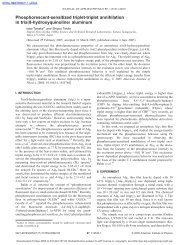Children's Television: Trends Around the World
Children's Television: Trends Around the World
Children's Television: Trends Around the World
Create successful ePaper yourself
Turn your PDF publications into a flip-book with our unique Google optimized e-Paper software.
CHILDREN’S TELEVISION: TRENDS AROUND THE WORLD<br />
107<br />
The United Kingdom was quick to perceive <strong>the</strong> potential dangers. British<br />
broadcasting for children had always been characterized by carefullyconstructed<br />
schedules balancing different program genres and screening for<br />
different age groups. In <strong>the</strong> early 1990s, alarm bells began to ring about <strong>the</strong><br />
disproportionate number of American-style children’s channels in this broadcasting<br />
culture. Influential in identifying <strong>the</strong> problem was a detailed survey of<br />
children’s programming, The Provision of Children’s <strong>Television</strong> in Britain:<br />
1992–1996, which was proposed by leading communications researcher, Jay<br />
G. Blumler. 5 Analysis of <strong>the</strong> changes in children’s television of all genres<br />
since <strong>the</strong> 1980s revealed that, although <strong>the</strong> amount—in both volume and<br />
time—of children’s programming had increased dramatically, <strong>the</strong> variety of<br />
programs was decreasing, with cartoons becoming dominant. Moreover, <strong>the</strong><br />
preponderance of cartoons on <strong>the</strong> new satellite and cable-delivered children’s<br />
channels was beginning to influence terrestrial channels, and this was undermining<br />
<strong>the</strong> cherished variety in British children’s programming. These findings<br />
led Blumler to call for a thorough inquiry into, and extensive discussion<br />
about, <strong>the</strong> provision of children’s television in <strong>the</strong> multichannel age.<br />
The Launch of Children’s Channels on Public <strong>Television</strong><br />
The questions raised by <strong>the</strong> British survey were found to be relevant in o<strong>the</strong>r<br />
countries, as well. In <strong>the</strong> latter half of <strong>the</strong> 1990s, new trends began emerging<br />
in public broadcasting for children throughout <strong>the</strong> world.<br />
Germany<br />
Until <strong>the</strong> introduction of commercial channels in 1984, <strong>the</strong> only children’s<br />
television available in Germany was produced and broadcast by German public<br />
television. Germany is <strong>the</strong> home of <strong>the</strong> international children’s television<br />
festival, <strong>the</strong> Prix Jeunesse International, 6 which testifies to <strong>the</strong> keen interest in<br />
<strong>the</strong> quality of children’s programs in that country. Moreover, German children’s<br />
programs have won numerous prizes in contests around <strong>the</strong> world.<br />
<strong>Television</strong> producers believe that children’s programs should be high quality,<br />
but provided in moderation.<br />
5 Kodaira Sachiko, “Igirisu no kodomo-muke terebi wa do kawatta ka” [Changes in Britain’s<br />
<strong>Television</strong> for Children], HKC (March 1998), pp. 2–15. The March 1998 issue of HKC provides<br />
details of <strong>the</strong> first two surveys. Details of <strong>the</strong> survey entitled The Provision of<br />
Children’s <strong>Television</strong> in Britain: 1992–1996 were published by <strong>the</strong> Broadcasting Standards<br />
Commission (BSC) in November 1997. An analysis of <strong>the</strong> results along with suggestions for<br />
future directions was published by Professor J. Blumler (BSC Research Working Paper: The<br />
Future of Children’s <strong>Television</strong> in Britain 1992). The results of <strong>the</strong> third survey are contained<br />
in Kam Atwal, Andrea Millwood Hargrave, Jane Sancho, Leila Agyeman, and Nicki Karet,<br />
What Children Watch: An Analysis of Children’s Programming Provision between<br />
1997–2001, and Children’s Views. BSC, ITC. 2003.







